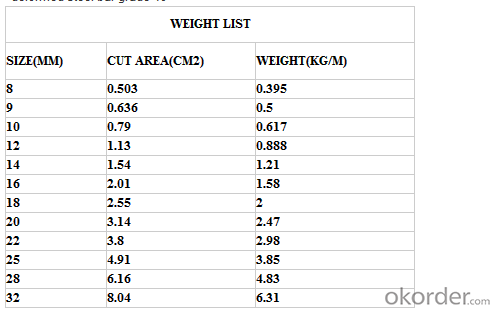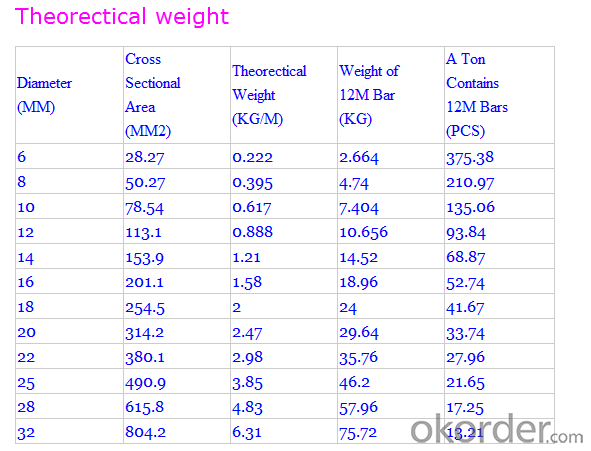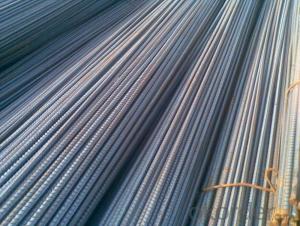6mm-32mm Cheap Export Deformed Steel Bar
- Loading Port:
- Shanghai
- Payment Terms:
- TT OR LC
- Min Order Qty:
- 100 m.t.
- Supply Capability:
- 1000 m.t./month
OKorder Service Pledge
OKorder Financial Service
You Might Also Like
deformed steel bar grade 40
material: HRB400, BS4449 GR460B
size: 8-36mmx12m.
short delivery time by bulk or container
deformed steel bar grade 40
material: HRB400, BS4449 GR460B
size: 8-36mmx12m.
short delivery time with bulk or container
packing: Mill standard export packing in bundles/coil, around 2tons/bundle.
country of Origin: China
delivery Time: Within a 35 days
Shipment: by bulk vessel or by container

Leading goods:
section steel:angles,channels,I-beam,H-beam;
coils:cold/hot rolled coils,PPGI,galvanized coils,plate,checkered plate,cutting steel plate,steel strip;
wire rod:steel wire,deformed wire,bar;
pipe:seamless pipe,rectangular pipe,welded pipe,spiral welded pipe,pipe fittings;
stainless steel:steel sheets,stainless steel strips,stainless bar,stainless tube;
special:weathering steel,shipbuilding steel;
construction steel:C-channel,Z-channel,T-bar,high-speed divider plate,corrugated steel plate,steel grating.
Advantage:
We are the spot supplier, Six huge warehouses which can hold 20,000 MT goods.
It makes the cost lower than others,we can provide the competitive price for you.
Delivery time:
Normal sizes can be provided in 7days, the others should be ready in 30---45 days.
Further treatment:
We can offer cutting,painting,drilling holes,bending,threading, welding,galvanization,packing etc.
Security interest:
We have already passed the ISO9001, BV and SGS authentication which makes the quality secured.
If you have the interest in any of the products we can provided, pls don't hesitate to connect with me. Looking forward to cooperate with you.

FAQ of Steel Deformed Bar
1. More than 10 years experience in this industry
2. 100,000 tons exporting per month
3. Professional foreign trade tea
4. OEM&ODM capacity
5. High quality assured & competitive price
6. Try our best to meet your needs & save your budget
7. Very popular in Southeast Asia, Africa, Mid-East and South America etc.
8. VIP membership system, first time customers and long-term cooperation customers can get extra discount on some products.
- Q:Are steel rebars eco-friendly?
- Steel rebars are not inherently eco-friendly due to how they are produced and the extraction of necessary raw materials. The production of steel involves extracting iron ore, which consumes a significant amount of energy and resources. Additionally, this process releases large amounts of carbon dioxide, contributing to greenhouse gas emissions and climate change. However, it is important to note that steel rebars have a long lifespan and can be recycled, which helps minimize their environmental impact. Recycling steel requires far less energy and resources compared to manufacturing it from scratch, and it aids in conserving natural resources and reducing waste. Furthermore, steel rebars are commonly utilized in construction projects because of their strength and durability. Utilizing them can result in the construction of long-lasting structures that require fewer repairs and replacements over time. This aspect of durability can contribute to an overall decrease in environmental impact. In summary, although steel rebars are not environmentally friendly during the production process, their longevity and recyclability can significantly reduce their environmental impact when compared to alternative construction materials.
- Q:What is the effect of fatigue on steel rebars?
- Fatigue can significantly weaken steel rebars, leading to a decrease in their structural integrity and potential failure under repeated or cyclic loading. This can result in cracks, fractures, or even complete breakage of the rebars, compromising the overall strength and stability of the reinforced concrete structure they support. Therefore, it is crucial to monitor and address fatigue in steel rebars to ensure the safety and longevity of the construction.
- Q:How do steel rebars affect the structural capacity of concrete beams and columns?
- The role of steel rebars in enhancing the structural capacity of concrete beams and columns cannot be overstated. These rebars serve as reinforcement, providing added strength and durability to the concrete elements. When steel rebars are incorporated into the concrete, the load-bearing capacity of the beams and columns is significantly increased. One of the main functions of steel rebars is to counteract the tensile forces that concrete alone cannot withstand. Concrete is strong under compression but weak under tension, which makes it prone to cracking and failure when subjected to tensile stress. By integrating steel rebars into the concrete, the tensile strength of the reinforced element is greatly improved. The steel rebars act as a framework within the concrete, distributing the load more evenly and reducing the risk of localized failure. When external loads or forces are applied, the rebars bear the tensile stress while the concrete maintains its compressive strength. This combination of materials creates a reinforced concrete element that can handle heavier loads, thus increasing the structural capacity of the beams and columns. Moreover, steel rebars also enhance the ductility and flexibility of the concrete elements. This means that the reinforced beams and columns can undergo greater deformations before reaching failure. The ability to deform without breaking is particularly important in regions prone to earthquakes, as it allows the structure to absorb and dissipate energy, thereby minimizing the risk of collapse. Additionally, steel rebars improve the resistance of concrete beams and columns against shrinkage and thermal stresses. Concrete tends to shrink as it cures and expand and contract due to temperature variations. The presence of steel rebars helps minimize these effects by providing a reinforcing network that restrains the concrete from excessive movements, preventing cracks and preserving the overall structural integrity. In conclusion, steel rebars have a profound impact on the structural capacity of concrete beams and columns. They enhance tensile strength, improve ductility, reduce shrinkage and thermal stresses, and increase overall load-bearing capacity. The combination of concrete and steel reinforcement produces a significantly stronger and more durable structural element that can withstand higher loads, ensuring the stability and safety of the entire structure.
- Q:How do steel rebars affect the overall creep and shrinkage of concrete structures?
- Steel rebars have a significant influence on the overall creep and shrinkage of concrete structures. The presence of rebars helps to control and minimize the shrinkage of concrete by providing restraint and reducing the amount of drying shrinkage. Additionally, rebars contribute to the overall stiffness of the structure, decreasing the potential for creep deformation over time. Therefore, steel rebars play a crucial role in mitigating both creep and shrinkage in concrete structures, ensuring their stability and durability.
- Q:What is the purpose of steel rebars?
- The purpose of steel rebars is to reinforce and strengthen concrete structures. Rebars, also known as reinforcing bars, are steel rods or wires that are used to provide additional strength to concrete by acting as a tension device. When embedded within the concrete, rebars help to distribute the applied loads more evenly, preventing the concrete from cracking or failing under pressure. This reinforcement is particularly important in structures such as buildings, bridges, and highways that are subjected to heavy loads or potential stress, as it enhances their durability and structural integrity. Steel rebars are widely used in construction projects as they are strong, durable, and resistant to corrosion, making them an essential component for ensuring the long-term stability and safety of concrete structures.
- Q:Can steel rebars be used in the construction of hotels and resorts?
- Yes, steel rebars can be used in the construction of hotels and resorts. Steel rebars are commonly used as reinforcement in concrete structures, providing strength and durability. In the construction of hotels and resorts, steel rebars are essential for reinforcing foundations, columns, beams, and other structural elements to ensure the safety and stability of the buildings.
- Q:Do steel rebars need to be coated with any protective materials?
- Yes, steel rebars often require a protective coating to prevent corrosion and extend their lifespan. Coatings such as epoxy, zinc, or galvanized coatings are commonly used to protect rebars from environmental factors and ensure their structural integrity in reinforced concrete structures.
- Q:What are lap splices in steel rebars?
- Lap splices in steel rebars refer to the method of connecting two rebars together by overlapping them and securing them with steel tie wires or mechanical splicing techniques. This is commonly done to create a continuous reinforcement in concrete structures, ensuring strength and stability.
- Q:Can steel rebars be used in structures with limited construction timeframes?
- Structures with limited construction timeframes can indeed utilize steel rebars. These rebars are frequently employed in construction projects due to their remarkable tensile strength, making them ideal for reinforcing concrete structures. Speedy and efficient installation is achievable with steel rebars, enabling faster construction compared to alternative reinforcement materials. Moreover, steel rebars offer durability and long-term stability, guaranteeing the integrity of the structure, even in time-constrained projects. Hence, employing steel rebars proves to be an effective solution for structures with limited construction timeframes, as they deliver both strength and swiftness in the construction process.
- Q:What is the lifespan of steel rebars in concrete structures?
- The lifespan of steel rebars in concrete structures can vary due to a range of factors. Generally, steel rebars are designed to provide concrete structures with durability and strength. Through proper design, construction, and maintenance, steel rebars can endure for many decades or even up to a century within concrete structures. One crucial factor that affects the lifespan of steel rebars is the quality of materials utilized. Rebars of high quality, which have corrosion-resistant coatings or are made of stainless steel, tend to last longer compared to regular carbon steel rebars. Moreover, the quality of the concrete used and its ability to shield the rebars from moisture and corrosive agents is also significant. Environmental conditions play a significant role in determining the lifespan of steel rebars. Exposure to harsh climates, such as regions with high humidity, saltwater, or acidic environments, can expedite corrosion and reduce the lifespan of the rebars. Adequate protective measures, such as maintaining the proper thickness of concrete cover, implementing waterproofing techniques, and utilizing corrosion inhibitors, can help extend the lifespan of steel rebars in such conditions. Maintenance and inspection are essential to ensure the longevity of steel rebars in concrete structures. Regular inspections should be conducted to detect signs of corrosion, cracking, or damage, and any necessary repairs or protective measures should be promptly undertaken. In certain cases, periodic coating or replacement of rebars may be necessary to uphold the structural integrity of the concrete elements. In conclusion, the lifespan of steel rebars in concrete structures can range from several decades to over a century, depending on various factors including material quality, environmental conditions, and proper maintenance. By implementing appropriate design, construction, and maintenance practices, the lifespan of steel rebars can be significantly prolonged, guaranteeing the long-term integrity and durability of the concrete structure.
1. Manufacturer Overview |
|
|---|---|
| Location | |
| Year Established | |
| Annual Output Value | |
| Main Markets | |
| Company Certifications | |
2. Manufacturer Certificates |
|
|---|---|
| a) Certification Name | |
| Range | |
| Reference | |
| Validity Period | |
3. Manufacturer Capability |
|
|---|---|
| a)Trade Capacity | |
| Nearest Port | |
| Export Percentage | |
| No.of Employees in Trade Department | |
| Language Spoken: | |
| b)Factory Information | |
| Factory Size: | |
| No. of Production Lines | |
| Contract Manufacturing | |
| Product Price Range | |
Send your message to us
6mm-32mm Cheap Export Deformed Steel Bar
- Loading Port:
- Shanghai
- Payment Terms:
- TT OR LC
- Min Order Qty:
- 100 m.t.
- Supply Capability:
- 1000 m.t./month
OKorder Service Pledge
OKorder Financial Service
Similar products
New products
Hot products
Hot Searches
Related keywords





























